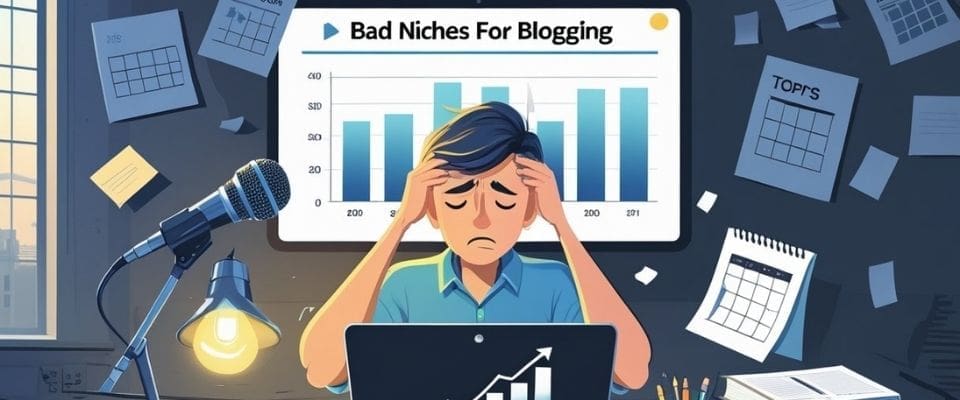Several widespread blogging myths are holding back thousands of people who could build successful blogs right now.
Indeed, many aspiring bloggers never start their online journey because they believe common blogging myths about what it takes to succeed. Moreover, you might think you need to be a tech expert, post daily, or wait for a massive audience before you can make money.
The truth is that blogging has evolved far beyond these outdated beliefs. You don’t need perfect design skills, endless free time, or years of writing experience to create valuable content that readers love.
This guide will separate fact from fiction by examining the biggest misconceptions about starting and growing a blog. Above all, you’ll discover why timing isn’t an issue, how small audiences can generate income, and what matters for blogging success in today’s digital landscape.
The Most Common Blogging Myths Explained
Many mistakes bloggers make are easily avoidable. A big part of the problem is the unrealistic expectations that arise from listening to online gurus. No, you’re not likely to make a million dollars in your first year, as surprising as that might seem.
Still, you can make money, and I guess you’re here for that. So, are you ready to find out the most common blogging myths that you can bust through to achieve success?

Blogging Is Easy Money
Blogging is not a get-rich-quick scheme. Indeed, many people enter the blogosphere expecting immediate financial returns, but this rarely happens.
Building a profitable blog requires months or years of consistent effort and dedication. I’m just entering my second year, and I’m still experimenting, still learning. Most successful bloggers understand that passive income requires a significant investment of time in creating content, learning SEO, and cultivating relationships with their audience before generating substantial revenue.
Above all, you need to establish trust and authority before monetisation becomes viable. This process involves understanding your niche, creating valuable content, and growing an engaged readership.
The reality is demanding. Many bloggers never earn substantial income from their efforts. Because results can be slow, many bloggers give up. However, those who do succeed typically treat blogging as a serious business venture rather than a hobby.
You Need Tons of Organic Traffic to Succeed
This myth prevents many bloggers from monetising their content effectively.
Quality matters more than quantity when building your readership. Therefore, a blog with 1,000 highly engaged readers often generates more income than one with 10,000 passive visitors.
Niche audiences offer advantages:
- Stronger community-building potential
- Better engagement with sponsored content
- Higher conversion rates for affiliate products
- More targeted email marketing opportunities
Organic traffic from search engines helps, but since the launch of AI Overview, it has become more challenging to get clicks to your posts.
These days, it’s crucial to become more savvy about generating traffic and attracting potential buyers. Therefore, email subscribers, social media followers, and regular commenters become your most valuable asset.
You can start monetising with relatively small numbers if your audience trusts your recommendations and finds your content genuinely helpful.
You Must Post Every Day to Be Successful
Good luck with that! Posting daily can lead to blogging burnout!
Above all, consistency matters more than daily publishing. I publish twice a week on average, although I sometimes publish more frequently. IIndeed, I was close to burnout from writing only two articles a week, juggling client work, YouTube, and life.
The truth is, you need help. Whether you hire someone or use AI for first drafts. I opted for the latter in the summer of 2025, because I couldn’t cope with my workflow. After trialling multiple AI writers, I opted for KoalaWriter. Certainly, it is the best and makes my life as a blogger much easier.
When I started, I was anti-AI writers. I even have it on record from a 2023 podcast with an SEO agency. I have eaten humble pie. After all, when you get busy, you must delegate, so why not use AI instead of paying a writer a hefty fee each month?
Read my review on KoalaWriter.
Blogging Is Dead
This persistent myth overlooks the ongoing growth and evolution of blogging.
Fact: Blogging has changed. It’s not dead unless you don’t change with the times.
Blogs continue to drive significant organic traffic and offer depth that social media posts cannot match. Search engines – and AI Overview – favour comprehensive blog content for informational queries.
Businesses continue to invest in blog content because it generates leads, builds authority, and improves search engine rankings. Personal bloggers find audiences for virtually every topic imaginable.
Rather than dying, blogging has evolved into a sophisticated content marketing tool that complements other digital strategies.
Barriers to Starting a Blog: Myths vs. Reality
Many people avoid entering the blogosphere because they believe false ideas about what it takes to start a blog. The truth is that you don’t need perfect writing skills, advanced technical knowledge, or thousands of pounds to begin blogging successfully.
You Need to Be a Natural Writer
You don’t have to be Shakespeare to start a blog. Many successful bloggers started with basic writing skills and refined them over time.
What matters more than perfect writing:
- Posting consistency
- Understanding your audience
- Authentic voice and personality
- Helpful content for your readers
Many readers prefer conversational, easy-to-understand writing over complex prose. Simple language often performs better than fancy vocabulary.
Focus on simple writing tips:
- Break up long paragraphs
- Use bullet points and headings
- Write like you’re talking to a friend
- Edit your work before publishing
Spelling and grammar tools like Grammarly can help catch mistakes, but the software can be a bit formal.
Read: 5 Simple Writing Hacks To Make Your Writing Irresistible
You Must Be Tech-Savvy to Start a Blog
Modern blogging platforms make it simple to start a blog without coding knowledge. You can launch a professional-looking blog in less than an hour.
Popular beginner-friendly platforms:
- WordPress.com (hosted version)
- Blogger
- Wix
- Squarespace
YouTube has thousands of free tutorials that show precisely how to set up a blog. Most platforms also provide step-by-step guides for beginners.
Start-Up Costs Are Too High
Starting a blog costs much less than most people think. You can begin blogging for under £100 per year.
Essential costs breakdown:
| Item | Annual Cost |
| Domain name | £10-15 |
| Basic hosting | £60-120 |
| Total | £70-135 |
Free options exist if you want to test blogging first. Platforms like WordPress.com and Blogger let you start without paying anything.
Free vs. paid comparison:
- Free blogs: Limited customisation, platform branding, restricted features
- Paid blogs: Custom domain, complete control, professional appearance, better monetisation options
You don’t need expensive themes, premium plugins, or professional photography when you’re just starting out. Begin with basic tools and focus your budget on quality hosting and a memorable domain name rather than fancy extras.
Roadblocks to a Successful Blog: Debunking Misconceptions
Many blogging myths create false barriers that stop people from starting their blogs or limit their growth potential. These misconceptions about personality requirements, perfectionism, and niche restrictions prevent countless potential bloggers from sharing their unique perspectives with the world.
Only Extroverts or Experts Can Succeed
This blogging myth suggests that you need an outgoing personality or years of expertise to build a successful blog. I’m an introvert, and we often do well blogging because we naturally prefer written communication over face-to-face interactions.
Many successful bloggers are quiet, thoughtful individuals who express themselves more effectively through writing. Your personality type doesn’t determine your blogging success.
Focus on providing value rather than proving your credentials. Share what you know, and write what people want to read, even if it’s basic knowledge to you.
Mistakes Mean Failure in Blogging
This harmful myth makes many bloggers abandon their blogs after minor setbacks. Mistakes are part of the learning process. You can’t “not” fail when you’re learning something new.
Every successful blogger has published posts with typos, grammar mistakes, chosen poor headlines, or written content that didn’t resonate. These experiences teach valuable lessons about what works and what doesn’t.
Technical issues, such as broken links or formatting problems, are not unusual. Your readers understand that blogs are works in progress.
The biggest mistake is letting perfectionism stop you from publishing. Done is better than perfect when you’re building your blogging skills and finding your voice.
You Must Focus on a Single Niche
This restrictive blogging myth claims that successful blogs must adhere to a single, narrow topic for the duration. Many thriving blogs cover multiple related interests without confusing their audience.
Your interests naturally overlap in interesting ways. A fitness blogger might also write about nutrition, mental health, and time management because these topics are closely related.
Starting with a broad focus lets you discover what resonates most with your audience. You can narrow down later based on which content performs best.
Personal brands allow more flexibility than topic-focused blogs. Readers follow you for your viewpoint, not just your expertise in one area.
The key is maintaining some connection between your topics. Random, unrelated posts can confuse readers, but related interests create a cohesive blog experience.
Many bloggers find their true niche after experimenting with different topics. Give yourself permission to explore rather than forcing artificial limitations.
The Truth About Growth and Profit
Many bloggers believe massive traffic is essential for profit, whilst others assume monetisation happens without effort. The reality shows that targeted audiences often outperform large, unfocused ones, and breaking into established niches remains possible with the right approach.
You Need Huge Traffic to Make Money
This myth stops many bloggers from monetising their content early. You don’t need millions of readers to generate income from your blog. Quality beats quantity every time.
A blog with 1,000 dedicated readers in a specific niche can earn more than one with 50,000 casual visitors.
Consider these monetisation strategies for smaller audiences:
- Affiliate marketing: Promote products your readers want
- Digital products: Create guides or courses for your niche
- Sponsored content: Partner with brands targeting your specific audience
- Email marketing: Build direct relationships with subscribers
A fitness blog with 2,000 engaged readers interested in home workouts can earn substantial income through equipment affiliate links. These readers trust your recommendations and buy products you suggest.
Monetisation Is Always Passive Income
The passive income myth misleads new bloggers about the reality of blog monetisation. Most successful blog income requires ongoing effort and maintenance.
From my experience, there’s nothing passive about building a blog.
Genuine passive income from blogging takes years to develop. Even affiliate links need regular updates, product research, and content refreshment to remain profitable.
Active monetisation methods include:
- Consulting services
- Freelance writing
- Online coaching
- Course creation and promotion
Semi-passive options require initial work but generate ongoing returns:
- Evergreen affiliate content
- Digital product sales
- Membership sites
Your organic traffic from search engines needs constant attention. Google algorithm changes can – and will – impact your rankings overnight. You must regularly update old posts and create fresh content to maintain visibility.
Successful monetisation combines multiple income streams. Don’t rely on a single source of revenue for your blog’s financial success.
Conclusion
Just today, I sat with a cup of coffee, staring into space and wondering if blogging is worth it. We all have days like that. Some of my results have been disappointing, although I now understand that my expectations were too high.
I have some fantastic affiliations with products I use daily, such as VidIQ (for my YouTube channel) and KoalaWriter (for writing first blog drafts), and I 100% believe in them. Still, people are sceptical. They think you’re just trying to make money. Yes, of course, that’s the point, but if you’re like me, you will only promote products that you use and have an excellent reputation.
Over time, people learn to trust your recommendations, but initially, it can be like pulling teeth.
In conclusion, creating digital products takes time. Everything takes time, and it’s the one thing we’re all short of.
Disclaimer: This post contains affiliate links. I may earn a commission if you sign up for a program or make a purchase using my link
FAQs
Is It True That You Can’t Be Successful In Blogging Without Writing Daily?
You don’t need to publish content every day to build a successful blog.
Many successful bloggers publish weekly or even monthly, while maintaining a strong readership. Your posting schedule should align with your ability to create high-quality content.
Focus on developing a realistic routine you can maintain long-term.
Do Blogs Require A Niche To Attract A Substantial Readership?
Focused blogs typically perform better than general ones because they attract specific audiences. You might get drawn to an unusual blog niche and make a killing with a fascinated audience.
Niche blogs make monetisation easier too. Companies prefer partnering with bloggers who reach their exact customer base.
Is It True That Technical Skills Are Essential For Blogging?
Modern blogging platforms make it easy to start without coding knowledge. WordPress, Squarespace, and similar services provide templates and user-friendly editors.
You can customise designs, add plugins, and manage content through simple interfaces. Most tasks involve clicking buttons rather than writing code.
Most skills are basic, and you can find YouTube tutorials to guide you through.
Is It True That Blogging Is No Longer Profitable Due To Market Saturation?
Blogging remains profitable despite increased competition. New opportunities emerge constantly as industries evolve, and audiences grow.
Multiple income streams make modern blogging more viable than ever. You can earn through ad revenue, affiliate marketing, courses, and sponsored content.
The key is providing genuine value rather than copying existing content. Readers will always seek new perspectives and better solutions to their problems.
Do You Need To Invest A Lot Of Money Upfront To Start A Successful Blog?
You can start blogging with minimal upfront costs. Indeed, free platforms like WordPress.com and Blogger allow you to begin without spending anything.
I started with shared WordPress hosting at £3 per month and recently upgraded to a VPS (virtual private server) at £9.60/month because my site was slowing down, which Google penalises. Primarily, I use KoalaWriter for first drafts, which starts at less than $10/month but can save your sanity!
I have the premium version of KoalaWriter, which is more costly but gives me 100,000 words per month.
Basic paid hosting costs around £3-£ 10 per month and provides more flexibility. A custom domain name cost varies depending on whether you choose a .co.uk or a .com domain. The latter is more expensive, though usually less than £15 a year.
The most significant investment is your time, not money. Therefore, you cannot underestimate the cost of your time for the long-term.








